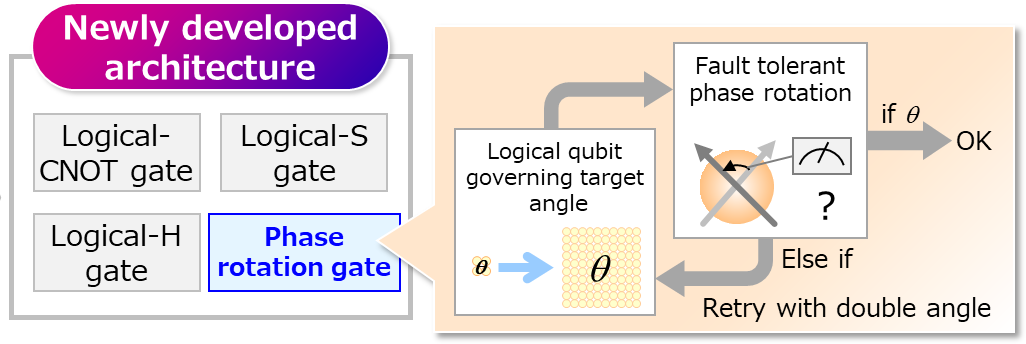
Fujitsu and Osaka University develop new quantum computing architecture, accelerating progress toward practical application of quantum computers
Realizing highly accurate quantum error correction even for quantum computers with about 10,000 physical qubits
News facts:
- New quantum computing architecture reduces number of physical qubits (1) required for quantum error correction to 10% of conventional architectures, enabling even quantum computers in the early FTQC era (2) with a maximum of 10,000 physical qubits to perform better than classical computers
- New architecture represents a significant milestone toward the construction of a quantum computer with 10,000 physical qubits and 64 logical qubits, accelerating progress toward the realization of genuine fault-tolerant quantum computation (3)
Fujitsu and Osaka University’s Center for Quantum Information and Quantum Biology (QIQB) today revealed the development of a new, highly efficient analog rotation quantum computing architecture, representing a significant milestone toward the realization of practical quantum computing. The new architecture reduces the number of physical qubits required for quantum error correction – a prerequisite for the realization of fault-tolerant quantum computing – by 90% from 1 million to 10,000 qubits. This breakthrough will allow research to embark on the construction of a quantum computer with 10,000 physical qubits and 64 logical qubits (4), which corresponds to computing performance of approximately 100,000 times that of the peak performance of conventional high performance computers.
Moving forward, Fujitsu and Osaka University will further refine this new architecture to lead the development of quantum computers in the early FTQC era, with the aim of applying quantum computing applications to a wide range of practical societal issues including material development and finance.
Error correction for fault-tolerant computing: making practical quantum a reality
Gate-based quantum computers are expected to revolutionize research in a wide range of fields including quantum chemistry and complex financial systems, as they will offer significantly higher calculation performance than current classical computers.
Logical qubits, which consist of multiple physical qubits play a major key role in quantum error correction technology, and ultimately the realization of practical quantum computers that can provide fault-tolerant results.
Within conventional quantum computing architectures, calculations are performed using a combination of four error-corrected universal quantum gates (5) (CNOT, H, S, and T gate). Within these architectures, especially quantum error correction for T-gates requires a large number of physical qubits, and rotation of the state vector in the quantum calculation requires repeated logical T-gate operations for approximately fifty times on average. Thus, the realization of a genuine fault-tolerant quantum computer is estimated to require more than one million physical qubits in total.
For this reason, quantum computers in the early FTQC era using conventional architecture for quantum error correction can only conduct calculations on a very limited scale below that of classical computers, as they work with a maximum of about 10,000 physical qubits, a number far below that required for genuine, fault-tolerant quantum computing.
To address these issues, Fujitsu and Osaka University developed a new, highly efficient analog rotation quantum computing architecture that is able to significantly reduce the number of physical qubits required for quantum error correction, and enable even quantum computers with 10,000 physical qubits to perform better than current classical computers, accelerating progress toward the realization of genuine, fault-tolerant quantum computing.
Fujitsu and Osaka University have been promoting joint R&D in quantum error correction technology including new quantum computation architectures for the early FTQC era at the “Fujitsu Quantum Computing Joint Research Division,” a collaborative research effort of the QIQB, established on October 1, 2021 at the campus of Osaka University as part of Fujitsu’s “Fujitsu Small Research Laboratory” program (6).
About the newly developed quantum computing architecture
By redefining the universal quantum gate set, Fujitsu and Osaka University succeeded in implementing a phase rotating gate – a world first– which enables highly efficient phase rotation, a process which previously required a high number of physical qubits and quantum gate operations.
In contrast to conventional architectures that required repeated logical T-gate operations using a large number of physical qubits, gate operation within the new architecture is performed by phase rotating directly to any specified angle.
In this way, the two parties succeeded in reducing the number of qubits required for quantum error correction to around 10% of existing technologies, and the number of gate operations required for arbitrary rotation to approx. 5% of conventional architectures. In addition, Fujitsu and Osaka University suppressed quantum error probability in physical qubits to about 13%, thus achieving highly accurate calculations.
The newly developed computing architecture lays the foundation for the construction of a quantum computer with 10,000 physical qubits and 64 logical qubits, which corresponds to computing performance of approximately 100,000 times that of the peak performance of conventional high performance computers.
Figure: Image of the newly developed quantum computing architecture
Credit: © 2023 Osaka University & Fujitsu Limited
Related Links
“Fujitsu and Osaka University Deepen Collaborative Research and Development for Fault-Tolerant Quantum Computers”
https://www.fujitsu.com/global/about/resources/news/press-releases/2021/1001-01.html
Center for Quantum Information and Quantum Biology (QIQB), Osaka University:
https://qiqb.osaka-u.ac.jp/en/
Fujitsu Quantum:
https://www.fujitsu.com/global/about/research/technology/quantum/
Fujitsu Small Research Lab:
Technical Glossary
- Physical qubit
Physical components of quantum computers; smallest unit of quantum information
- Early FTQC era
An era where quantum computers work with only a maximum of 10,000 physical qubits and FTQC is considered to be impossible to realize
- Fault-tolerant quantum computation (FTQC)
Fault-tolerant quantum computation achieved through the correction of quantum errors
- Logical qubit
Consisting of multiple physical qubits; smallest logical unit, error-corrected through redundancy
- Universal quantum gate
A plurality of quantum gates that can perform all quantum calculations by combining them. Equivalent to AND, XOR, and NOT gates of current computers
- Fujitsu Small Research Lab
Initiative where Fujitsu researchers are embedded at technology incubators at universities in Japan and internationally to conduct joint research with some of the leading minds in their fields, including professors as well as the next generation of researchers.
